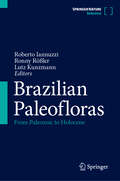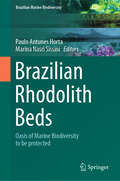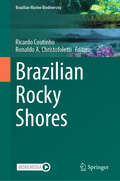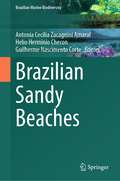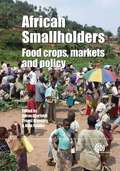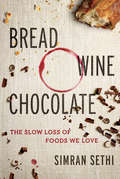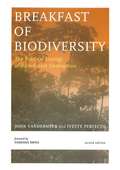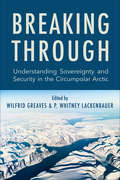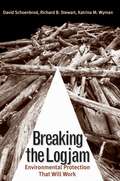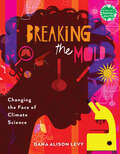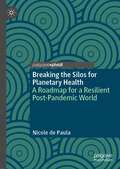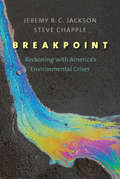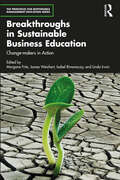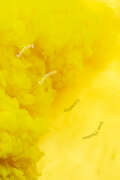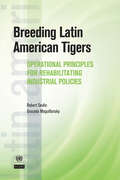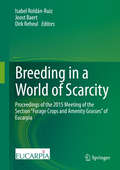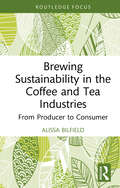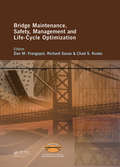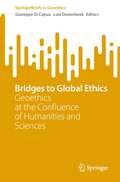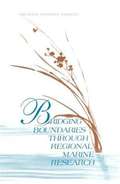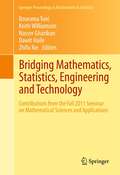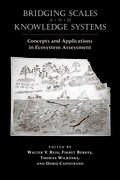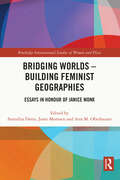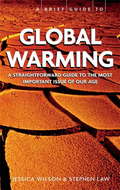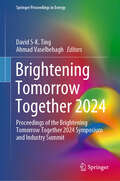- Table View
- List View
Brazilian Paleofloras: From Paleozoic to Holocene
by Roberto Iannuzzi Ronny Rößler Lutz KunzmannThis book will cover the entire evolutionary history that the terrestrial plants have recorded in Brazilian sedimentary rocks, ranging from the first vestiges of terrestrial environments colonization about 400 million years ago, until reaching the eve of the present time, when the current vegetation formations were organizing to reach their current distribution, diversity and structure in modern biomes. At present Brazil is home to the world's greatest plant biodiversity and we aim to offer here an opportunity to appreciate how this floral biodiversity originated and developed in these lowlands of South America, through chapters elaborated by the best Brazilian paleobotanist and palynologists in collaboration with foreign experts who dedicate to elucidate the evolution of the ancient flora in this part of the planet.
Brazilian Rhodolith Beds: Oasis of Marine Biodiversity to be protected (Brazilian Marine Biodiversity)
by Paulo Antunes Horta Marina Nasri SissiniRhodolith beds form biogenic reefs, oases of high biodiversity in sedimentary seabed environments. The rhodoliths are foundation species, which provide shelter and substrata for important and abundant benthic communities. Currently they have been recognized as an important player to the carbon balance, contributing to the planetarium climatic equilibrium. In Brazil, these environments are frequent and abundant and can be major carbonate ‘factories’ with a key role in the biogeochemical cycling of carbon in the South Atlantic Ocean. However, these organisms and environments are under threat from climate change, particularly ocean acidification and global warming, as well as local stressors such as fishing impacts and coastal run-off. In our book, written by dozens of researchers from different regions and expertise, you will dive more deeply in these and many other subjects related to this wonderful and vulnerable pink and dynamic underwater ecosystems.
Brazilian Rocky Shores (Brazilian Marine Biodiversity)
by Ricardo Coutinho Ronaldo A. ChristofolettiRocky shores correspond to a very particular habitat in Brazil, which is concentrated in the Southeastern and Southern coasts. There are different types of substrata and seascapes that cause a high environmental heterogeneity responsible to host a high species biodiversity and a range of ecosystem services. Primary and secondary production, as well as structuring organisms and processes, differs from temperate areas.
Brazilian Sandy Beaches (Brazilian Marine Biodiversity)
by Antonia Cecilia Zacagnini Amaral Helio Herminio Checon Guilherme Nascimento CorteMore than 4000 beaches distributed along the Brazilian coastline are one of the country's main assets. They harbor endemic and diverse biota and provide numerous goods and services essential to human populations. However, they are under increasing pressure, trapped between the impacts of climate change and human activities in the terrestrial and marine environment, and the knowledge about their environmental characteristics and biodiversity is still insufficient to ensure their preservation. This book is the first-ever comprehensive work about Brazil's sandy beaches addressing their physical, ecological, and social aspects. It was written by an interdisciplinary group of leading Brazilian researchers from different regions of the country and also had the contribution of a few international experts. The information synthesized in this book is accessible to anyone who wants to know more about Brazilian coastal biodiversity and represents a significant step towards conserving Brazilian sandy beaches, their biodiversity, and ecosystem services.
Bread, Beer and the Seeds of Change
by Thomas Sinclair Carol SinclairThe history of humankind is intimately tied to the history of agriculture: powerful societies rose, persisted and waned in parallel with their food supply systems. Describing what crops were grown, the constraints on their production and the foods that were obtained, this book traces the impact of cropping and food preparation in ten societies that were among the most powerful and influential in history, detailing how technology varied and developed as it related directly to agriculture and food production. The book covers the background of agricultural development, early agricultural societies, and the advancement of technology from the ancient Greeks and Romans to the present. It finishes by addressing the implications for the future of agriculture and food supply as grain production moves towards biofuels. A compelling text for all those interested in the history of society and civilisations, global agriculture, and what it means for the future, this text is also an essential reference for students of agriculture, food technology, history and anthropology.
Bread, Wine, Chocolate: The Slow Loss of Foods We Love
by Simran SethiAward-winning journalist Simran Sethi explores the history and cultural importance of our most beloved tastes, paying homage to the ingredients that give us daily pleasure, while providing a thoughtful wake-up call to the homogenization that is threatening the diversity of our food supply.Food is one of the greatest pleasures of human life. Our response to sweet, salty, bitter, or sour is deeply personal, combining our individual biological characteristics, personal preferences, and emotional connections. Bread, Wine, Chocolate illuminates not only what it means to recognize the importance of the foods we love, but also what it means to lose them. Award-winning journalist Simran Sethi reveals how the foods we enjoy are endangered by genetic erosion—a slow and steady loss of diversity in what we grow and eat. In America today, food often looks and tastes the same, whether at a San Francisco farmers market or at a Midwestern potluck. Shockingly, 95% of the world’s calories now come from only thirty species. Though supermarkets seem to be stocked with endless options, the differences between products are superficial, primarily in flavor and brand.Sethi draws on interviews with scientists, farmers, chefs, vintners, beer brewers, coffee roasters and others with firsthand knowledge of our food to reveal the multiple and interconnected reasons for this loss, and its consequences for our health, traditions, and culture. She travels to Ethiopian coffee forests, British yeast culture labs, and Ecuadoran cocoa plantations collecting fascinating stories that will inspire readers to eat more consciously and purposefully, better understand familiar and new foods, and learn what it takes to save the tastes that connect us with the world around us.
Breakfast Of Biodiversity
by Vandana Shiva Ivette Perfecto John VandermeerThe continuing devastation of the world's tropical rain forest affects us all-spurring climate change, decimating biodiversity, and wrecking our environment's resiliency. Millions of worried people around the world want to do whatever it takes to save the forest that is left.But halting rain forest destruction means understanding what is driving it.In Breakfast of Biodiversity, John Vandermeer and Ivette Perfecto insightfully describe the ways in which such disparate factors as the international banking system, modern agricultural techniques, rain forest ecology, and the struggles of the poor interact to bring down the forest. They weave an alternative vision in which democracy, sustainable agriculture, and land security for the poor are at the center of the movement to save the tropical environment.
Breaking Through: Understanding Sovereignty and Security in the Circumpolar Arctic
by P. Whitney Lackenbauer Wilfrid GreavesGlobalization, climate change, and increased geopolitical competition are having a profound impact on the Arctic, affecting how we understand both sovereignty and security within the region. In Breaking Through, a diverse group of emerging and established scholars examine Arctic sovereignty and security, rarely examined together, and present a theoretically robust study of Arctic sovereignty and security in both historical and contemporary contexts. Throughout the volume, readers will discover fresh perspectives on under-studied dimensions of Arctic sovereignty, including: environmental changes, foreign and security policies, and how Indigenous peoples interact to produce different meanings of sovereignty and security in the Arctic. Drawing on extensive primary and secondary research, Breaking Through offers important and timely conclusions for policymakers, advocates, scholars, and students.
Breaking the Logjam: Environmental Protection That Will Work
by David Schoenbrod Richard B. Stewart Katrina M. WymanAfter several decades of significant but incomplete successes, environmental protection in the United States is stuck. Administrations under presidents of both parties have fallen well short of the goals of their environmental statutes. Schoenbrod, Stewart, and Wyman, distinguished scholars in the field of environmental law, identify the core problems with existing environmental statutes and programs and explain how Congress can fix them. Based on a project the authors led that incorporated the work of more than fifty leading environmental experts, this book is a call to action through public understanding based on a nonpartisan argument for smarter, more flexible regulatory programs to stimulate the economy and encourage green technology.
Breaking the Mold: Changing the Face of Climate Science (Books for a Better Earth)
by Dana Alison LevySixteen scientists. Protecting our planet. Making science more equitable.Scientists who collect microbes from surfers' skin, who use radar sensors to gather data miles away, who combat inequality by pushing for cleaner air policies. Each with their own story, all working to make life better for future generations.Celebrated author Dana Alison Levy profiles 16 people, all studying different elements of the earth&’s landscape, animals, and climate, who defy stereotypes of who can be a scientist. From analytical chemists to volcanologists, from global experts to recent graduates, these scientists share what they were like as young people, how they got where they are now, and what they—and the rest of us—can do to help the planet.Based on extensive interviews and featuring infographics and personal photos, Breaking the Mold offers a snapshot of the people and organizations fighting to make science more equitable. Back matter includes advice for readers interested in science careers, DIY projects, paths to community involvement, and more.Books for a Better Earth are designed to inspire children to become active, knowledgeable participants in caring for the planet they live on.
Breaking the Silos for Planetary Health: A Roadmap for a Resilient Post-Pandemic World
by Nicole de PaulaThis book translates the latest theoretical perspectives on the emerging field of Planetary Health Studies into the practical reality of global political decision makers. It builds on the scientific data on the impacts of environmental change on human health to propose practical methods for operationalizing planetary health. The book maps opportunities for decision makers to break institutional silos and engage with bottom-up approaches that can transform planetary health from a global idea into a local reality. The analysis frames human health in the Anthropocene, an era in which humans have become the most powerful force affecting global ecosystems, and reveals new existential risks for humankind.Departing from ongoing multilateral efforts to promote sustainability, the author’s analysis places the agenda of planetary health on the desk of political decision makers, still underrepresented at planetary health gatherings. Given the pressing need to implement sustainable development policies, the book presents planetary health as an overarching framework for global policy targets, notably the UN Sustainable Development Goals, the Paris Agreement on Climate Change, and the post-2020 biodiversity framework under the UN Convention on Biological Diversity. The book is timely in offering a concrete road map for practitioners and researchers interested in transforming the concept of planetary health into reality. With a collection of success stories, the analysis dwells on tools for community engagement, opportunities for health professionals training, gender empowerment, digital health, and innovative ways to enhance human well-being on a changing planet.
Breakpoint: Reckoning with America's Environmental Crises
by Jeremy B. Jackson Steve ChappleAn insightful look at the American environmental crisis and emerging solutions from the heartland to the coasts in the era of global climate change†‹ Eminent ecologist Jeremy B. C. Jackson and award†‘winning journalist Steve Chapple traveled the length of the Mississippi River interviewing farmers, fishermen, scientists, and policymakers to better understand the mounting environmental problems ravaging the United States. Along their journey, which quickly expands to California, Florida, and New York, the pair uncovered surprising and profound connections between ecological systems and environmental crises across the country. Artfully weaving together independent research and engaging storytelling, Jackson and Chapple examine the looming threats from recent hurricanes and fires, industrial agriculture, river mismanagement, extreme weather events, drought, and rising sea levels that are pushing the country toward the breaking point of ecological and economic collapse. Yet, despite these challenges, the authors provide optimistic and practical solutions for addressing these multidimensional issues to achieve greater environmental stability, human well†‘being, and future economic prosperity. With a passionate call to action, they look hopefully toward emerging and achievable solutions to preserve the country’s future.
Breakthroughs in Sustainable Business Education: Change-makers in Action (The Principles for Responsible Management Education Series)
by Isabel Rimanoczy Linda Irwin Morgane Fritz James WeichertAround the globe, faculty and higher education leaders are actively changing what they teach to create a sustainable world. This book shares how to transition to programs and courses that teach sustainable business management practices critical for success.Students are demanding more than the same business courses taught for half a century. Faculty are wondering if they have the expertise to include sustainable business practices. Easy to read and relatable, this book provides tactical ideas for transitioning from current business curriculum to courses for a sustainable future. It compiles insights and recommendations from 28 global experts who have put ideas into practice. Each chapter addresses integration of sustainability topics into existing subject areas and offers ideas for adding new courses or concepts to ground business in the context of the global socio-environmental community.The book offers actionable ways that administrators and faculty can immediately begin transitioning their business curriculum to one that is socially and environmentally sustainable.
Breathing Aesthetics
by Jean-Thomas TremblayIn Breathing Aesthetics Jean-Thomas Tremblay argues that difficult breathing indexes the uneven distribution of risk in a contemporary era marked by the increasing contamination, weaponization, and monetization of air. Tremblay shows how biopolitical and necropolitical forces tied to the continuation of extractive capitalism, imperialism, and structural racism are embodied and experienced through respiration. They identify responses to the crisis in breathing in aesthetic practices ranging from the film work of Cuban American artist Ana Mendieta to the disability diaries of Bob Flanagan, to the Black queer speculative fiction of Renee Gladman. In readings of these and other minoritarian works of experimental film, endurance performance, ecopoetics, and cinema-vérité, Tremblay contends that articulations of survival now depend on the management and dispersal of respiratory hazards. In so doing, they reveal how an aesthetic attention to breathing generates historically, culturally, and environmentally situated tactics and strategies for living under precarity.
Breeding Latin American Tigers: Operational Principles for Rehabilitating Industrial Policies in the Region
by Robert Devlin Graciela MoguillanskyThis book is motivated by the emerging rehabilitation of industrial policies as a tool for supporting economic transformation and high rates of growth in developing countries. It argues that underperforming disciples of the Washington Consensus' 'market fundamentalism' should learn and practice the art of systemic industrial policies, which requires a medium-long term strategic perspective and intelligent proactive state interventions in markets. However, it also stresses that rehabilitation requires that industrial policies be developed and implemented in a context of home- grown public-private alliances that avoid state 'capture' by special interests. It first examines the 'how' of industrial policy in the public sectors of ten non-Latin American countries in Asia, Europe, and Oceania that have been successful in promoting economic catch-up with rich countries, or have performed better than Latin American countries with similar resource endowments. The book defines '10+1' generic First Principles for the use, design, and execution of modern industrial policies, and then examines the experiences of nine Latin American and Caribbean governments against these First Principles. The authors identify large gaps in the organizational and operational effectiveness of their public sectors, and suggest ways to close these gaps.
Breeding in a World of Scarcity: Proceedings of the 2015 Meeting of the Section “Forage Crops and Amenity Grasses” of Eucarpia
by Isabel Roldán-Ruiz Joost Baert Dirk ReheulThis book includes papers presented at the 2015 meeting of the Fodder Crops and Amenity Grasses Section of Eucarpia. The theme of the meeting "Breeding in a world of scarcity" was elaborated in four sessions: (1) scarcity of natural resources, (2) scarcity of breeders, (3) scarcity of land and (4) scarcity of focus. Parts I to IV of this book correspond to these four sessions. Session 1 refers to the consequences of climate change, reduced access to natural resources and declining freedom in using them. Plant breeding may help by developing varieties with a more efficient use of water and nutrients and a better tolerance to biotic and abiotic stresses. Session 2 refers to the shrinking number of field breeders. There is a need for a mutual empathy between field- and lab-oriented breeding activities, integrating new methods of phenotyping and genotyping. Session 3 underscores the optimal use of agricultural land. Forage needs to be intensively produced in a sustainable way, meeting the energy, protein and health requirements of livestock. Well-adapted varieties, species and mixtures of grasses and legumes are needed. Session 4 refers to the fading of focus in primary production triggered by a range of societal demands. There are few farmers left and they are asked to meet many consumer demands. Both large-scale, multi-purpose species and varieties and specialized niche crops are required. Part V summarizes the conclusions of two open debates, two working group meetings and two workshops held during the conference. The debates were devoted to the future of grass and fodder crop breeding, and to feed quality breeding and testing. The conference hosted meetings of the working groups "Multisite rust evaluation" and "Festulolium". Workshops focused on "genomic selection and association mapping" and on "phenotyping" with applications in practical breeding research. Part V contains also short sketches of breeding ideas presented as short communications.
Brewing Sustainability in the Coffee and Tea Industries: From Producer to Consumer (Earthscan Food and Agriculture)
by Alissa BilfieldThis book focuses on the often intertwined industries of coffee and tea, using accounts of single producer communities to highlight the transformation from plantation-style colonial agriculture towards systems that now claim to produce social and environmental benefits from the farm to the cup. Focusing on the dynamics of farmers' experiences producing coffee and tea ethically and sustainably at origin, the book shows how these values are transmitted and reinforced throughout the value chain. Exploring tandem case studies of fair trade cooperatives in Guatemala and Sri Lanka, it provides an insight into the creation of more sustainable value chains from producer to consumer in the global marketplace, incorporating the perspectives of coffee exporters, importers, roasters, and café owners. This book is focused on the prospects of the specialty movement in food as a catalyst for forging more authentic, just, and sustainable supply chains that consider both people and the environment. This book will be of great interest to students and scholars of food and agriculture, sustainable food systems and supply chains, the fair trade movement, sustainable development, and social entrepreneurship and social innovation.
Bridge Maintenance, Safety, Management and Life-Cycle Optimization: Proceedings of the Fifth International IABMAS Conference, Philadelphia, USA, 11-15 July 2010 (Bridge Maintenance, Safety and Management)
by Dan M. Frangopol Richard Sause Chad S. KuskoBridge Maintenance, Safety, Management and Life-Cycle Optimization contains the lectures and papers presented at IABMAS 2010, the Fifth International Conference of the International Association for Bridge Maintenance and Safety (IABMAS), held in Philadelphia, Pennsylvania, USA from July 11 through 15, 2010.All major aspects of bridge maintenance, s
Bridges to Global Ethics: Geoethics at the Confluence of Humanities and Sciences (SpringerBriefs in Geoethics)
by Giuseppe Di Capua Luiz OosterbeekThis book contributes to the current discussion on geoethics and global ethics within the geoscience and humanities communities. It provides new content and insights into developing convergent human actions in response to global anthropogenic changes, based on perspectives that make it possible to combine geoscience knowledge with humanities and social sciences approaches. Selected authors present their reflections, findings and insights regarding the vision of geoethics (ethics of responsibility towards the Earth) as global ethics from philosophical, humanities and social sciences perspectives. In addition, they discuss ethical frameworks from diverse cultural traditions, searching for points of intersection with geoethics. The goal: for global environmental problems to be managed via multi-perspective approaches that can more effectively accommodate complexity. Combining the strengths of the geosciences, humanities and social sciences can pave the way for a paradigm shift in how human societies develop adaptive, sustainable responses to environmental changes and societal inequalities.
Bridging Boundaries through Regional Marine Research
by Committee on the Assessment of Regional Marine Research ProgramsInformation on Bridging Boundaries through Regional Marine Research
Bridging Mathematics, Statistics, Engineering and Technology: Contributions from the Fall 2011 Seminar on Mathematical Sciences and Applications (Springer Proceedings in Mathematics & Statistics #24)
by Bourama Toni Dawit Haile Keith Williamson Nasser Ghariban Zhifu XieThis volume contains the invited contributions from talks delivered in the Fall 2011 series of the Seminar on Mathematical Sciences and Applications 2011 at Virginia State University. Contributors to this volume, who are leading researchers in their fields, present their work in a way to generate genuine interdisciplinary interaction. Thus all articles therein are selective, self-contained, and are pedagogically exposed and help to foster student interest in science, technology, engineering and mathematics and to stimulate graduate and undergraduate research and collaboration between researchers in different areas. This work is suitable for both students and researchers in a variety of interdisciplinary fields namely, mathematics as it applies to engineering, physical-chemistry, nanotechnology, life sciences, computer science, finance, economics, and game theory.
Bridging Scales and Knowledge Systems: Concepts and Applications in Ecosystem Assessment
by Fikret Berkes Walter Reid Doris Capistrano Walter Millennium Ecosystem Assessment Walter World Resources Institute Thomas WilbanksBridging the gap between local knowledge and western science is essential to understanding the world's ecosystems and the ways in which humans interact with and shape those ecosystems. This book brings together a group of world-class scientists in an unprecedented effort to build a formal framework for linking local and indigenous knowledge with the global scientific enterprise. Contributors explore the challenges, costs, and benefits of bridging scales and knowledge systems in assessment processes and in resource management. Case studies look at a variety of efforts to bridge scales, providing important lessons concerning what has worked, what has not, and the costs and benefits associated with those efforts. Drawing on the groundbreaking work of the Millennium Eco-system Assessment, Bridging Scales and Knowledge Systems will be indispensable for future efforts to conduct ecosystem assessments around the world.
Bridging Worlds - Building Feminist Geographies: Essays in Honour of Janice Monk (Routledge International Studies of Women and Place)
by Janet Momsen Ann M. Oberhauser Anindita DattaThis book marks the 30th anniversary of the IGU Commission on Gender and Geography, honouring the contributions of Janice Monk in establishing the field of feminist geography. The collection is published as part of the series International Studies of Women and Place that Janice Monk co-edited with Janet Momsen for over 30 years. The chapters, from over 45 leading international scholars, encompass key areas Monk has contributed to within feminist geography. The collaborative nature of this project reflects the networks and themes Monk nurtured throughout her long and impactful career. The book provides critical insights to wide-ranging topics that include the development of feminist geography in different global contexts, gendered geographies of work and everyday life, and gender and environmental concerns. Diverse voices and perspectives in this book will serve as invaluable resources for scholars interested in gender and feminist geographies, the history of the IGU Commission on Gender and Geography, career trajectories of women geographers in different parts of the world, gendered geographies of the life course, as well as feminist analyses of environmental issues. The book will be useful to students, educators, and activists in gender studies, development studies, and human geography.
Brief Guide - Global Warming, A (Brief Histories)
by Stephen Law Jessica WilsonIt now seems certain that our planet is warming. Is it the result of human activity and if so how do we combat it? This reasoned and reasonable guide helps to clarify the controversial issues and the way forward.An accessible guide to climate change that not only gives reasonable answers to the big questions surrounding the issue, but also takes us inside the corridors of power and the basements of the United Nations, where countries are engaged in a game of climate-change poker. For the individual, wondering whether to sell their seaside property or invest in a small wind-farm, this book offers sensible answers. It gives us the best and worst case scenarios and sets out how we can each address this contentious but vital issue.
Brightening Tomorrow Together 2024: Proceedings of the Brightening Tomorrow Together 2024 Symposium and Industry Summit (Springer Proceedings in Energy)
by David S-K. Ting Ahmad VaselbehaghThis book includes the proceedings of the Symposium and Industry Summit, June 20-21, 2024 at University of Windsor Negativity and pessimism seem to dominate the media in recent years, overshadowing the bright side of our beautiful planet and disheartening its inhabitants. Not to deny the prevailing challenges, but tomorrow is far from complete ruin and doom. Brightening Tomorrow Together aims at bringing optimists from many disciplines of expertise and walks of life together to synergise existing know-how and further the latest technologies and measures to hasten the brightening of tomorrow. This book is part of the big dream of the Turbulence and Energy Laboratory. It strives to bring together a diverse group to exchange state-of-the-art progresses and to promote collaborations across different disciplines to hasten the brightening of tomorrow together. Topics of interest include engineering cleaner energy, improving our understandings of water and wastewater, reducing waste and pollution at all fronts, and actualizing eco-friendly agriculture and living.
